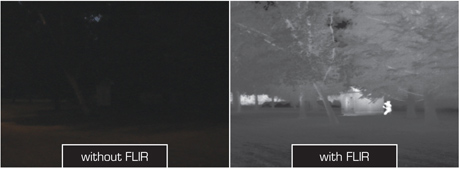FLIR Systems broke a historic threshold in thermal camera pricing when it announced a thermal camera for $499 at the ISC West show in April. Before that announcement, the lowest-price thermal camera was $2,000, which was itself much lower than the $10,000 price just a few years ago in 2005. The price decrease resulted from FLIR’s R&D efforts specifically aimed at lowering the cost of its Lepton thermal camera core.
FLIR uses that core in its own cameras – including the $499 model – and it will also be used by other thermal imaging suppliers in the market. Andy Teich, FLIR’s CEO, says having multiple suppliers selling thermal cameras in the space builds awareness and overall credibility for the technology. FLIR has about a 50 percent market share as a supplier of uncooled thermal camera cores and is the largest producer by at least a factor of two over the nearest competition. If you take defence contractors out of the mix, the market share number is even higher. In all, the commercial security space makes up about 20 percent of FLIR’s business.
“The two biggest barriers [to greater thermal camera usage] are price and awareness,” says Teich. “The price side is very visible, but awareness is more subtle.” FLIR is involved in a range of awareness-building activities, promoting the use of thermal imaging in training classes, at trade show, in white papers, and using RVs traveling across the United States. “It’s a lot of grass-roots stuff,” says Teich. “We’re paving roads. It’s hard work and expensive.”
|
|
| Thermal does a good job of sensing animals, or people or water, all of which show up well because of temperature differences |
FLIR operates according to the mantra “infrared everywhere” and promotes use of infrared imaging not just in security but in a range of markets, from building inspection cameras to radiation detectors to automobiles. Teich sees a time when every consumer security camera will have a thermal image element in it, complementing the capabilities of the visible light sensor. A key element of “infrared everywhere” is widespread thermal camera usage (and the resulting greater awareness) in the consumer space. Mass availability of lower-cost thermal imaging products in the consumer market provides a basis for greater usage in other markets, including commercial security applications. If consumers better understand the value proposition of thermal, it paves the way for usage at all levels of the market. Teich says “a bigger base builds a bigger top.”
Given the lower pricing, Teich lists three specific “mainstream” security markets where thermal imaging can have the greatest impact:
Outdoor perimeter security. False alarms have historically been a big problem for video motion detection and video analytics applications deployed outdoors at a facility’s perimeter. Rain, snow and other obscurants can make it difficult to get a usable data feed for video analytics from visible cameras, which also cannot see in the darkness. Infrared illuminators are essentially useless in rain or snow. In contrast, lower-cost thermal cameras provide true 24/7 capabilities, and thermal images are not plagued by variables that can cause excessive false alarms in systems that use visible light.
| |
| Thermal images are not plagued by variables causing excessive false alarms in systems that use visible light |
Indoor applications. Light variations are also a problem indoors, but thermal cameras provide images that reliably show the presence of people in any lighting situation. Temperature-sensing aspects of thermal imaging also make it easy detect a water leak or pre-emergent fire.
Building systems. Thermal imaging makes it easy to count the number of people in a room no matter what the lighting conditions, which can provide a valuable data feed into HVAC systems or lighting controls.
Use of thermal imaging eliminates a lot of the variables that have discouraged greater usage of video analytics, such as light level changes, shadows, and things rustling in the breeze. Thermal data feeds provide a much better platform for effective use of video analytics, making video analytics “truly useful and reliable,” says Teich. Extraneous elements do not show up on a thermal image, which is based on differences in temperature among elements in a scene. Thermal imaging also makes it easy to separate things like people (which have a different temperature) from a background. Thermal does a good job of sensing animals, or people or water, all of which show up well because of temperature differences.
Teich predicts that thermal cameras will be commonplace both at the consumer level and at the industrial level in the next five years.


